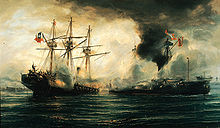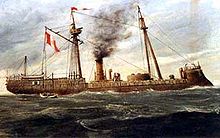- Naval Campaign of the War of the Pacific
-
Ironclads of Chile and Peru at the beginning of the War of the Pacific[1] Warship tons
(L.ton)Horse-
powerSpeed
(Knots)Armour
(Inch)Main Artillery Built
Year Cochrane
Cochrane3,560 2,000 9-12,8 up to 9 6x9 Inch 1874  Blanco Encalada
Blanco Encalada3,560 3,000 9-12,8 up to 9 6x9 Inch 1874  Huascar
Huascar1.130 1,200 10-11 4½ 2x300-pounders 1865  Independencia
Independencia2,004 1,500 12-13 4½ 2x150-pounders 1865  Manco Cápac
Manco Cápac1.034 320 6 10 2x500-pounders 1864  Atahualpa
Atahualpa1.034 320 6 10 2x500-pounders 1864 Naval Campaign
Land Campaign
Chipana - Iquique - Punta Gruesa - 1st Antofagasta - 2nd Antofagasta - Rímac - Angamos - Pilcomayo - 1st Arica - 2nd Arica - Callao
Topáter - San Francisco - Tarapacá - Los Ángeles - Tacna - Arica - Chorrillos - Miraflores - Lima - San Pablo - Pachia - La Concepción - HuamachucoThe Atacama Desert was a rough terrain to conquer and occupy for long. It was nearly waterless and had few roads and railroads. From the beginning of the war it became clear that, to seize or defend the local nitrate resources in a difficult desert terrain, control of the sea would be the deciding factor.[2]
Contents
In 1879 Bolivia didn't possess any ships, but on March 26, 1879 Daza formally offered letters of marque to any ships willing to go to combat for Bolivia.[3] Bolivia hadn't signed the Paris Declaration Respecting Maritime Law but the USA, England and France stood by the treaty and refused to accept the legality of Bolivia's act. Since Bolivia hadn't any more because Chile hand occupied them, and because Peru discouraged the use of Letters of Marque, the naval conflict was left to be resolved between Chile and Perú.
The power of the Chilean navy was based on the twin central-battery ironclad frigates, Cochrane and Blanco Encalada. The rest of the fleet was formed by the corvettes O'Higgins, Chacabuco, Abtao, and Esmeralda, the gunboat Magallanes, and the schooner Covadonga.
The Peruvian navy based its power on the broadside ironclad frigate Independencia and the monitor Huáscar. The rest of the fleet was completed by the corvette Unión, the gunboat Pilcomayo, and the coastal monitors Atahualpa and Manco Cápac, purchased from the United States at the end of the Civil War The coastal monitors cannot be classed among the sea-going ships of Perú as they were permanently stationed, one at Callao and the other at Arica.[4] Although both the Chilean and Peruvian ironclads seemed evenly matched, the Chilean ironclads had twice the armor and held a greater range and hitting power.
Wooden Steamboats of Chile and Peru at the beginning of the War of the Pacific[5] Warship tons
(L.ton)Horse-
powerSpeed
(Knots)Main Artillery Built
Year O'Higgins
O'Higgins1,101 300 12 3x115-2x70-2x12-pounders 1874  Chacabuco
Chacabuco1,101 300 11 1x115-2x70-2x12-pounders 1874  Abtao
Abtao1,051 300 8 3x115-3x30-pounders 1870  Magallanes
Magallanes772 260 11,5 1x115-1x64-2x20-pounders 1874  Covadonga
Covadonga412 140 7 2x70-3x40-pounders 1859  Esmeralda
Esmeralda854 200 8 16x32-2x12-pounders 1855  Unión
Unión1.150 320 13 12x68-1x9-pounders 1864  Pilcomayo
Pilcomayo600 180 10,5 2x70-4x40-pounders 1864 Engagements
Blockade and battle of Iquique
Main articles: Battle of Iquique and Battle of Punta GruesaIn one of the first naval tactical moves of the war, the Peruvian port of Iquique was blocked by of the Chilean Navy. In the Battle of Iquique, which took place on May 21 of 1879, the Peruvian monitor Huáscar, sank the Chilean corvette Esmeralda. At around the same time, the Peruvian frigate Independencia, chased the Chilean schooner Covadonga through shallow coastal zones until the heavier Independencia rammed against a rock and run aground in Punta Gruesa. The strategic result of the naval battles of Iquique and Punta Gruesa were to lift of the blockade of the port of Iquique.
Excursions of the Huáscar
The outgunned Huáscar managed to avoid engagement with the superior battleships of the Chilean navy for six months. Among the actions of these "Excursions of the Huáscar" are the Battle of Antofagasta (May 26, 1879) and the Second Battle Antofagasta (August 28, 1879). The most successful of the excursions was the capture of the steamship Rímac on July 23, 1879. Not only was the ship captured, but the cavalry regiment Carabineros de Yungay which was on board was also captured, making this the largest loss of the Chilean army so far. This caused a crisis in the Chilean government[6](p78) which in turn caused the resignation of Admiral Juan Williams Rebolledo commander of the Chilean fleet, who was replaced by Commodore Galvarino Riveros Cárdenas, who devised a plan to catch the Huáscar.
Battle of Angamos
Main article: Battle of AngamosThe decisive battle of the sea campaign took place in Punta Angamos, on October 8, 1879.[7] In this battle, the monitor Huáscar was finally captured by the Chilean Navy, despite the attempts of its crew to scuttle the ship and keep it out of enemy hands.[8] Finally the Peruvian Navy was completely defeated during the blockade of Callao,[9] where the Peruvian fleet was set on fire and the coastal defenses of Callao were destroyed or captured and taken to Chile.[10]
Blockade of Arica
Blockade of Callao
Warships of Chile and Peru at the beginning of the War of the Pacific[11] Warship Deplacement
(Long ton)Horsepower Speed
(Knots)Iron armour
(Inch)Number of Guns
x Lb[12]Built
YearIronclads Chile Cochrane 2.082 500 13 9½ 6x250 2x20 2x9 1874 Blanco Encalada 2.082 500 13 9½ 6x250 2x20 2x9 1874 Peru Huáscar 1.180 300 11 4½ 2x250 1864 Independencia 2.004 550 11 4½ 2x150 12x70 4x32 4x9 1864 Manco Capac 1.084 880 4 10 2x500 Smoothbore 1864 Atahualpa 1.084 350 4 10 2x500 Smoothbore 1864 Wooden ships Chile Esmeralda 854 200 8x40 4x80 2x6 older O'Higgins 1.101 800 8x115 2x70 4x40 2x6 1874 Chacabuco 1.101 800 8x115 2x70 4x40 2x6 1874 Covadonga 412 140 2x70 1x40 older Magallanes 772 260 1x115 1x64 2x20 1874 Abtao 1.051 300 1x150 4x82 1870 Peru Unión 1.150 400 12x70 1x9* 1864 Pilcomayo 600 180 2x70 4x40 4x12 1873 References
- ^ William F. Sater, "Andean Tragedy", page 113-114.
- "There are numerous differences of opinion as to the ships' speed and armament. Some of these differences can be attributed to the fact that the various sources may have been evaluating the ships at different times."
- ^ Bruce W. Farcau, "The ten Cents War", page 65:
- "As the earlier discussion of the geography of the Atacama region illustrates, control of the sea lanes along the coast would be absolutely vital to the success of a land campaign there"
- ^ William F. Sater, "Andean Tragedy", page 102 and ff:
- "… to anyone willing to sail under Bolivia's colors …"
- ^ Thomas Wallace Knox "Decisive Battles Since Waterloo" page 435
- ^ Cap. Jorge Ortiz Sotelo, "Miguel Grau", page 70-71.
- ^ B.W. Farcau, "The Ten Cents War"
- ^ Bruce W. Farcau, "The Ten Cents War", page 83:
- "As long as the odds had been before against the allies, they seemed truly insurmountable now."
- ^ William F. Sater, "Andean Tragedy", page 159:
- "Garezon [the last Peruvian commander] did his best to deny the Chileans a trophy: he commanded Chief Engineer MacMahon to open the seacocks to scuttle the ship"
- ^ Elías Murguía, Julio J. (1980). Marinos peruanos en Arica. Peru: Instituto de Estudios Histórico-Maritimos del Perú. p. 38. http://books.google.com/books?id=2KIKAQAAIAAJ&source=gbs_navlinks_s. Retrieved July 22, 2009.
- ^ Basadre, Jorge (1961). Historia de la República del Perú. Michigan: Ediciones "Historia". p. 2538. http://books.google.com/books?id=9nt-AAAAMAAJ&source=gbs_book_other_versions_r&cad=5. Retrieved July 22, 2009.
- ^ See Mariano Paz Soldan, "Narración histórica de la Guerra de Chile contra el Perú y Bolivia", Imprenta y Librería de Mayo, calle Perú 115, 1884, page 114
- ^ Weight of the projectile in pounds
Categories: - ^ William F. Sater, "Andean Tragedy", page 113-114.
Wikimedia Foundation. 2010.


